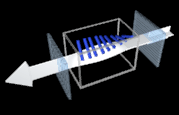Twisted Cells
 In a laptop screen, the liquid crystal is sandwiched between two plates of
glass. One plate has horizontal grooves in it; the other has vertical ones.
The molecules like to align themselves with these grooves, so the two plates
create a layer of horizontal molecules and a layer of vertical ones at the
outside edges of the sandwich. The layers in between do their best to align
themselves with their neighbors; they gradually spiral from horizontal to
vertical. The result is called a "twisted cell" of liquid crystal:
In a laptop screen, the liquid crystal is sandwiched between two plates of
glass. One plate has horizontal grooves in it; the other has vertical ones.
The molecules like to align themselves with these grooves, so the two plates
create a layer of horizontal molecules and a layer of vertical ones at the
outside edges of the sandwich. The layers in between do their best to align
themselves with their neighbors; they gradually spiral from horizontal to
vertical. The result is called a "twisted cell" of liquid crystal:
| Click on a molecule and drag with the mouse to see the helix from different angles. |
 That looks suspiciously like the chain of twisted polarizers we saw earlier ...
That looks suspiciously like the chain of twisted polarizers we saw earlier ...
 Excellent intuition! The mechanism is somewhat different, but the result is
the same: the direction of polarization is rotated.
Excellent intuition! The mechanism is somewhat different, but the result is
the same: the direction of polarization is rotated.


Click here if you want to find out what the mechanism is.
| Here's a picture of a beam of polarized light passing through the twisted molecules; notice the two perpendicular filters. |

|
 So that twisted light is what lights up the laptop pixels. But how can you
make different shades of colors on the screen? You would have to be able to
control how much light gets through that second filter.
So that twisted light is what lights up the laptop pixels. But how can you
make different shades of colors on the screen? You would have to be able to
control how much light gets through that second filter.






